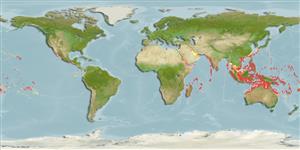>
Syngnathiformes (Pipefishes and seahorses) >
Syngnathidae (Pipefishes and seahorses) > Nerophinae
Etymology: Dunckerocampus: From Duncker, an ichthyologist and taxonomist that recognized four Gobiidae families (1928) + Gr, kampe = bent.
More on author: Bleeker.
Environment: milieu / climate zone / depth range / distribution range
पारिस्थितिकी
समुद्री प्रवाल-भित्ति संयुक्त; गहराई सीमा 5 - 56 m (Ref. 1602). Tropical; 33°N - 26°S
Indo-Pacific: Red Sea and East Africa to Samoa, north to Japan (Ref. 559), south to Australia.
आकार / वज़न / Age
Maturity: Lm ? range ? - ? cm
Max length : 19.0 cm TL पुल्लिंग / अलिंग; (Ref. 4281)
पृष्ठीय रीढ़ (सम्पूर्ण): 0; पृष्ठीय सौफट रेज़ (सम्पूर्ण): 20-26; गुदा कांटा 0; ऐनल सौफट रेज़: 4. Usually with one dark band crossing opercle (Ref. 4281).
Adults inhabit tide pools, lagoons, and outer reef slopes. Found in caves and crevices. Ovoviviparous (Ref. 205). Feeds on small invertebrates (Ref. 89972). The male carries the eggs in a brood pouch which is found under the tail (Ref. 205). Have been reared in captivity (Ref. 35416). Solitary, pairs or in small aggregations in caves or under ledges (Ref 90102).
Life cycle and mating behavior
परिपक्व अवधि | पुनरुत्पत्ति | मछलीऔ का अंडे देना | अंडे | Fecundity | लार्वा
Male carries the eggs in a brood pouch (Ref. 205).
Myers, R.F., 1991. Micronesian reef fishes. Second Ed. Coral Graphics, Barrigada, Guam. 298 p. (Ref. 1602)
IUCN Red List Status (Ref. 130435)
Threat to humans
Harmless
Human uses
जलजीवालय: सार्वजनिक लजीवालय
अधिक जानकारी
संदर्भजलीयकृषिजलीयकृषि रूपरेखाखींचआनुवंशिकीElectrophoresesहैरेटिबिलटीबीमारीप्रक्रमणNutrientsMass conversion
साधन
Special reports
Download XML
इंटरनेट स्रोत
Estimates based on models
Preferred temperature (Ref.
123201): 24.8 - 29, mean 27.8 °C (based on 672 cells).
Phylogenetic diversity index (Ref.
82804): PD
50 = 0.5078 [Uniqueness, from 0.5 = low to 2.0 = high].
Bayesian length-weight: a=0.00085 (0.00032 - 0.00224), b=3.04 (2.81 - 3.27), in cm total length, based on LWR estimates for this (Sub)family-body shape (Ref.
93245).
Trophic level (Ref.
69278): 3.8 ±0.55 se; based on food items.
लौटाव (Ref.
120179): ऊंचा, न्यूनतम जनसंख्या दुगनी समय अवलागत 15 महीने। (Preliminary K or Fecundity.).
Fishing Vulnerability (Ref.
59153): Low vulnerability (10 of 100).
Nutrients (Ref.
124155): Calcium = 93.5 [54.0, 188.5] mg/100g; Iron = 0.776 [0.447, 1.440] mg/100g; Protein = 18.2 [17.0, 19.3] %; Omega3 = 0.128 [0.074, 0.232] g/100g; Selenium = 37.4 [19.3, 82.4] μg/100g; VitaminA = 78.1 [26.7, 221.2] μg/100g; Zinc = 1.39 [0.94, 2.00] mg/100g (wet weight);
